ASUS’s first gaming handheld, ROG Ally, was finally born this year after years of preparation. The current version uses AMD Ryzen Z1 Extreme APU, and the recommended price in Taiwan is 23,999 yuan. It will be officially launched on June 13. Following the media preview, let’s see how ROG Ally really performs with the sample machine provided by ASUS.

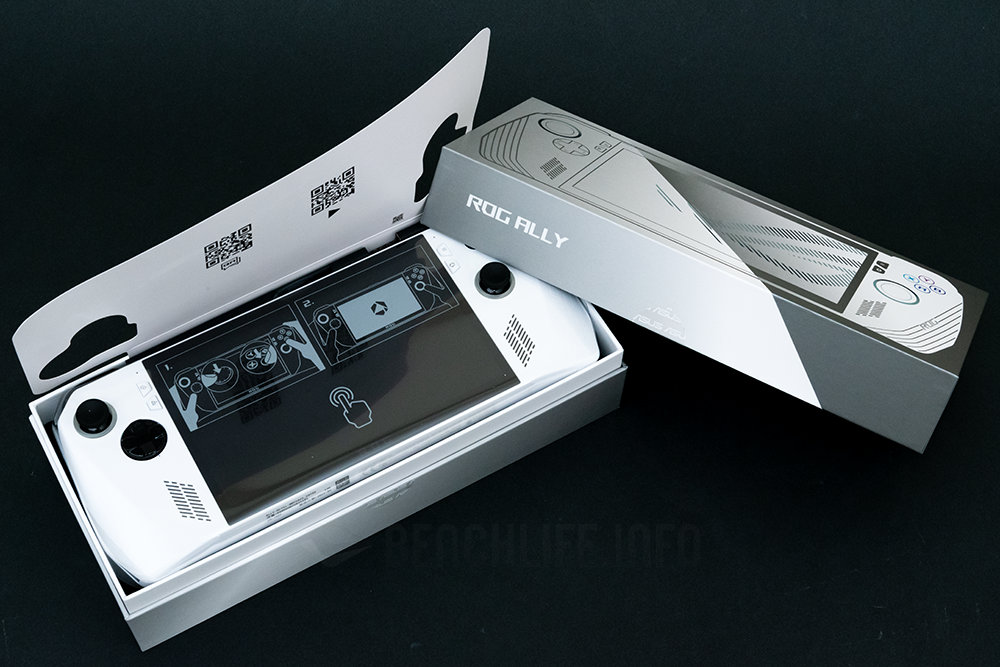
As mentioned in the previous media preview meeting, ROG Ally is paired with dedicated peripheral devices. In addition to game consoles, it can also be a home TV entertainment/game console, or it can be transformed into a gaming desktop with XG Mobile independent graphics and monitors. Its random accessories are simple, only Type-C power supply device (USB PD 65W), and a simple bracket and product guide. The power supply unit attached to the sample machine is a bit interesting, it looks the same as the one attached to the laptop, except that there is an extra ROG logo sticker.
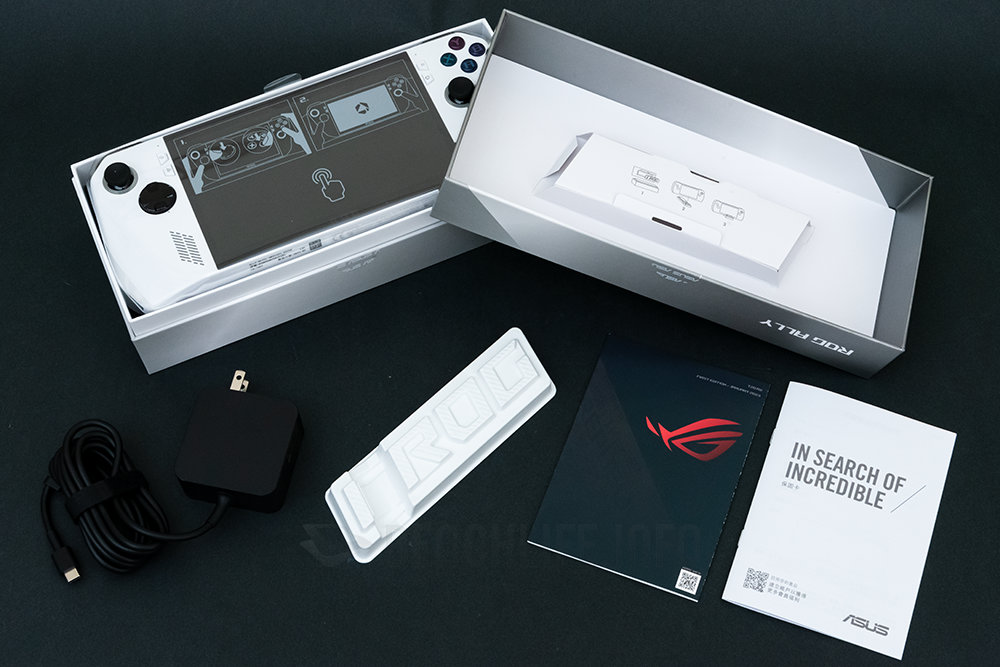
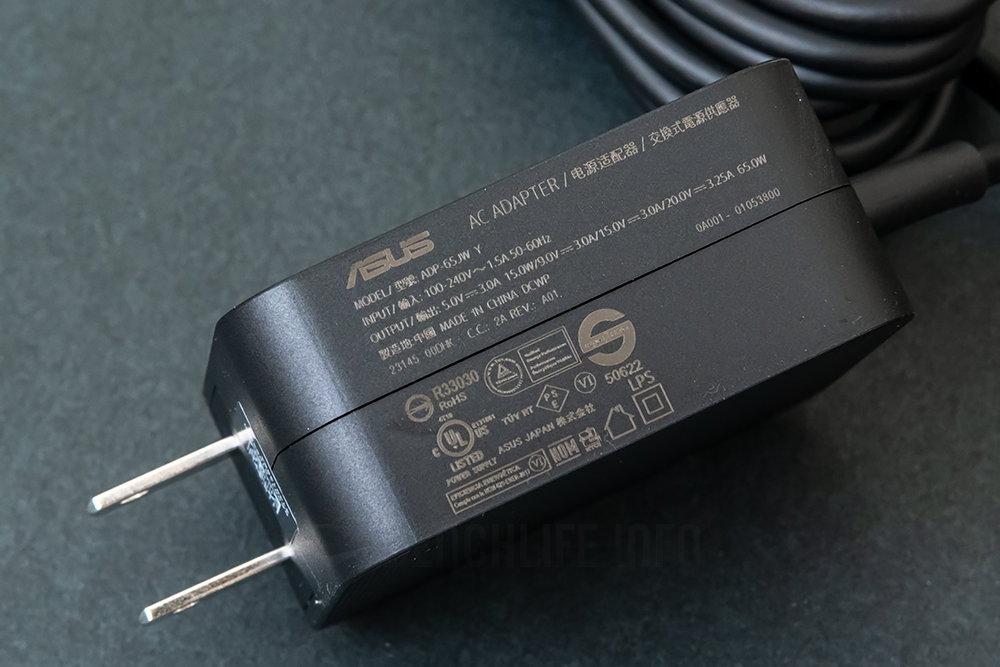
ROG Ally external mechanism design
ROG Ally is equipped with a 7-inch display panel, and the whole machine shell is made of plastic material with a frosted texture. The size is 28.0 x 11.1 x 2.12-3.24cm, and the weight is 608g. ASUS has spent many years thinking about ergonomics. After all, it is a game for a living, but there are too many factors to consider. With the current technology, it may not be able to ask for more, and it still has a bit of a brick feel. It is more likely that there is a workaround, which is probably the white body. Can more color options be provided in the future?
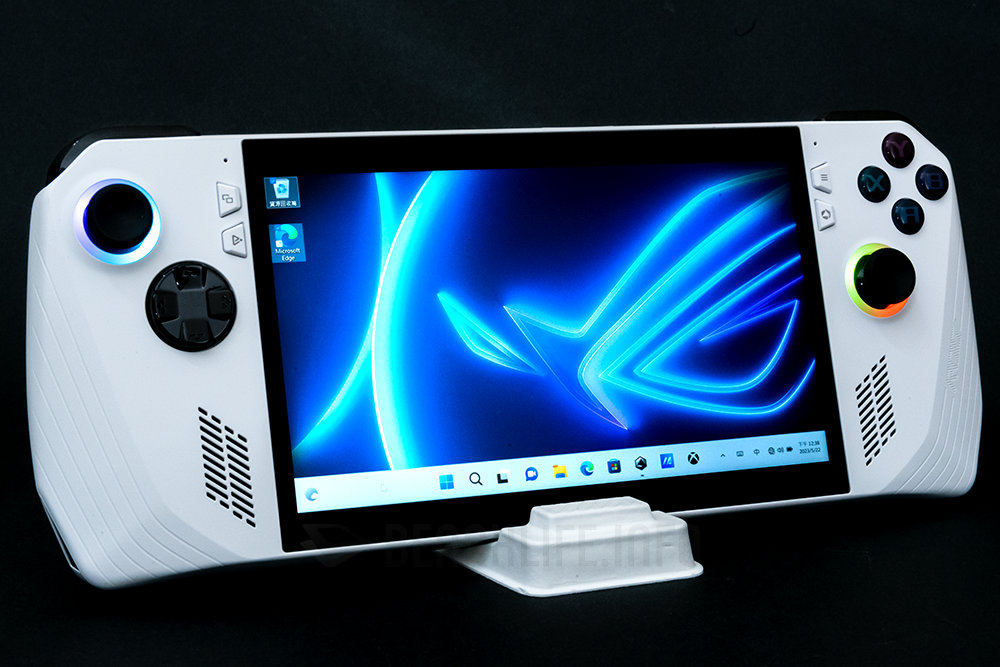
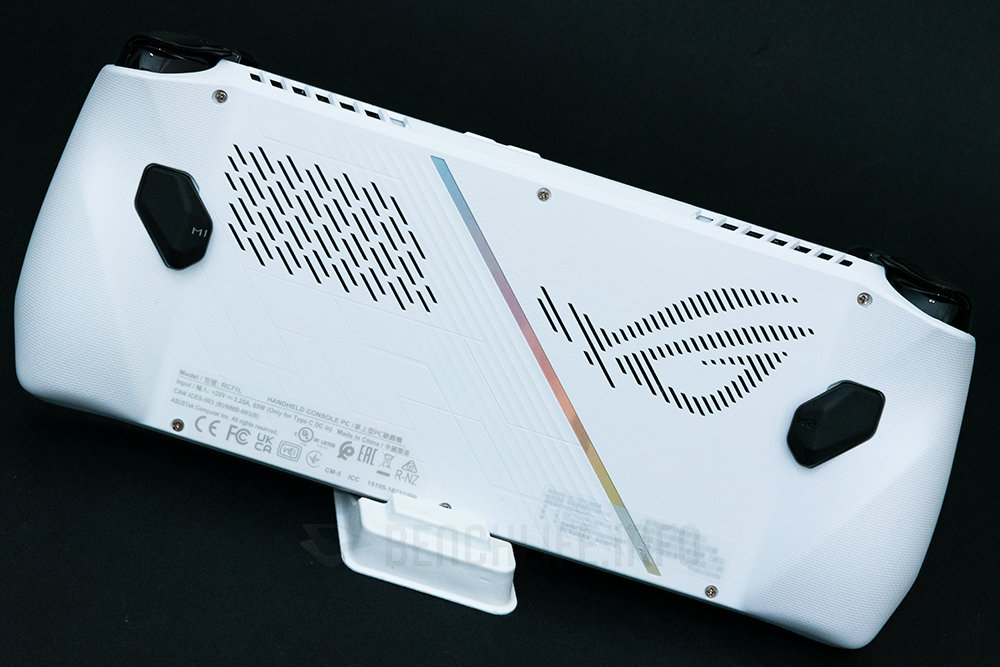
The I/O interface is optimized for handheld operation, all concentrated on the top of the fuselage, including 3.5mm audio input and output terminals, microSD UHS-II card reader, ROG XG Mobile interface, USB 3.2 Gen 2 Type-C (supports USB PD, DP 1.4 Alt Mode), volume adjustment keys, indicator lights, power switch (supports Windows Hello fingerprint recognition), etc., and also has built-in Wi-Fi 6E / Bluetooth wireless modules, gyroscope and other devices.
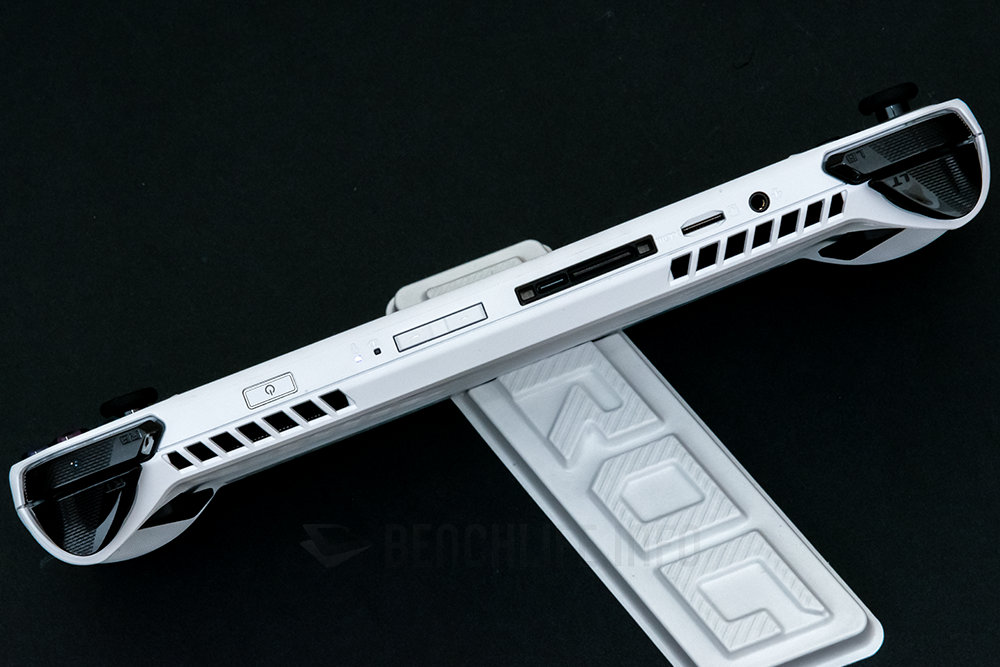
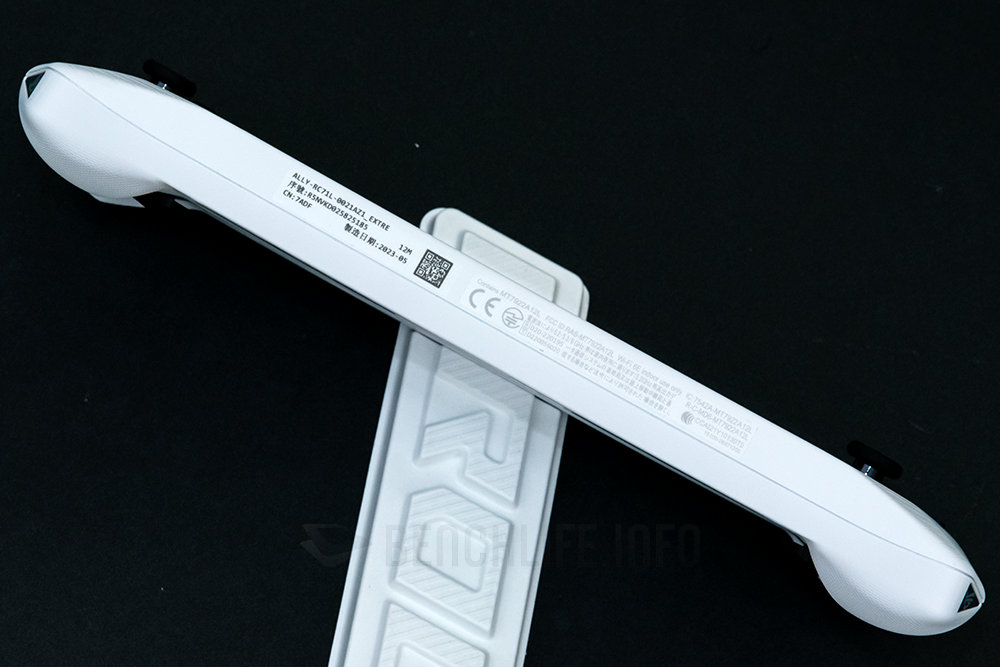
Part of the audio-visual experience comes from the 7-inch IPS touch display panel. The general specifications are Full HD resolution, 120Hz refresh rate, response time 7ms, maximum brightness 500nits, and contrast 1000:1. In addition to supporting FreeSync Premium, it also has 10 points Touch function. Although ASUS emphasizes that the color gamut covers 100% of sRGB, the color depth can only reach 8bpc, and it does not support HDR.
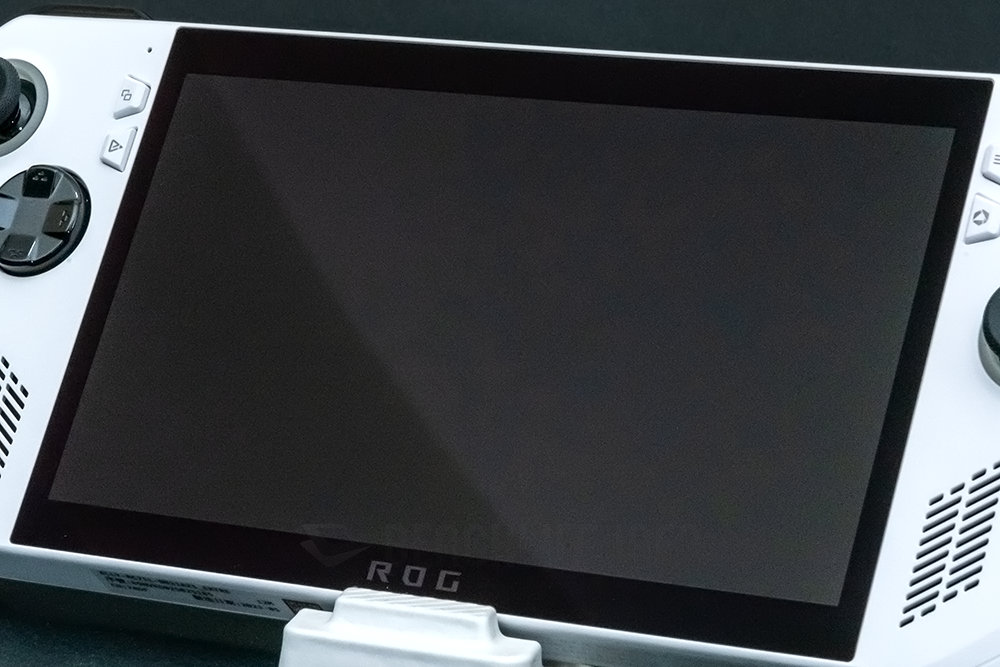
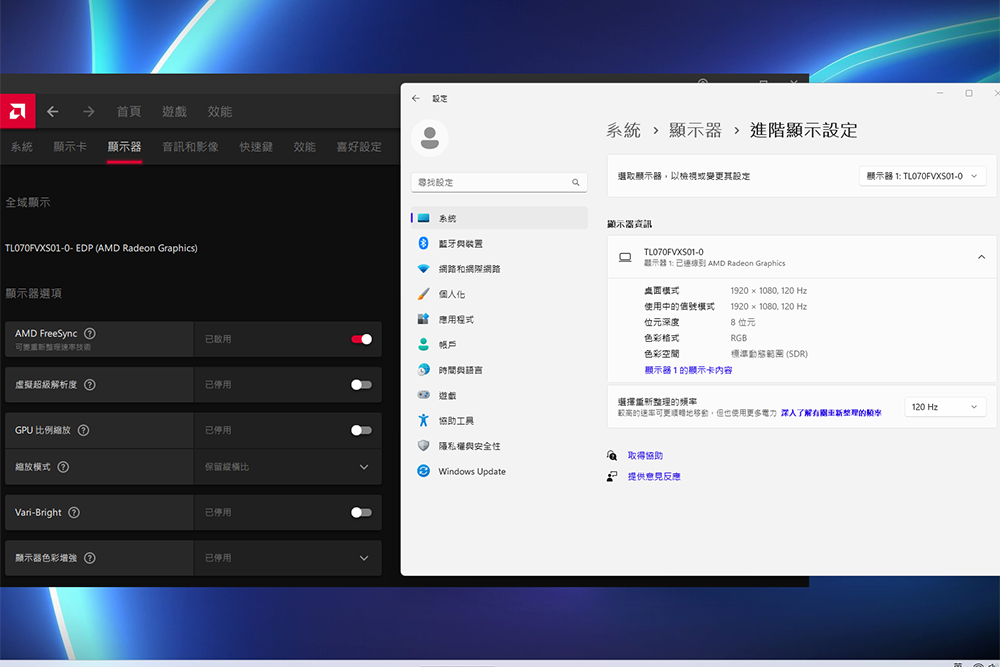
The outer layer of the screen is covered with Corning Gorilla Glass Victus and treated with Corning Gorilla Glass DXC coating, emphasizing low reflectivity and good scratch resistance and impact resistance. As for the dual speaker units (1W x 2) on both sides of the screen, it is equipped with a SmartAMP smart amplifier and supports Hi-Res Audio, and provides virtual surround sound through Dolby Atmos, and there is a microphone that supports AI noise reduction on the top.
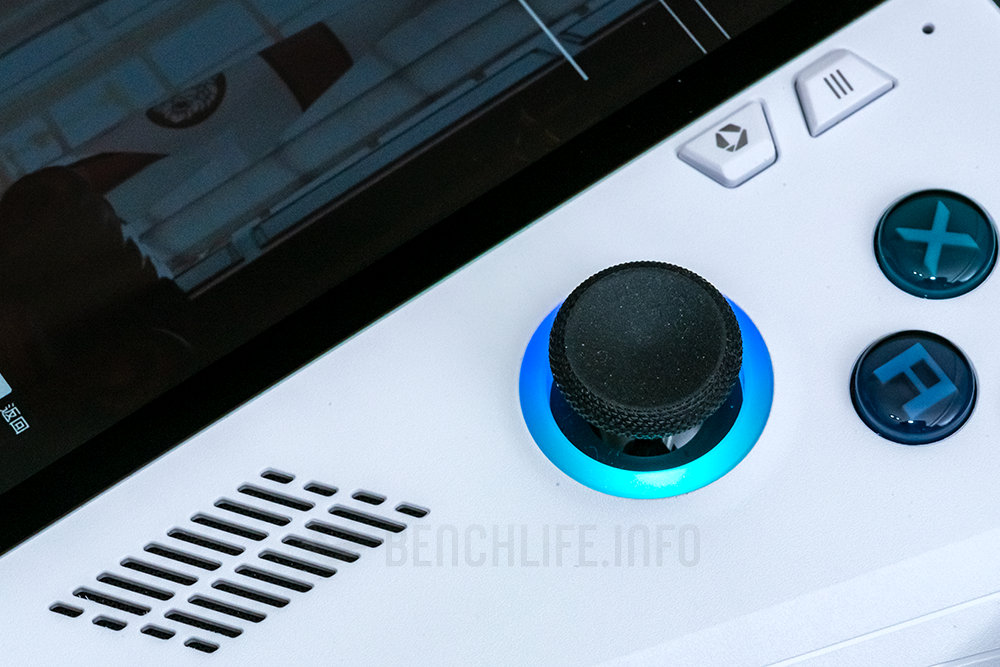
The configuration of the ROG Ally game keys is similar to that of the Xbox controller. The materials used have been inked with special emphasis on durability and other characteristics. 2 customizable buttons. The mushroom head of the joystick is slightly smaller than the Xbox controller, and the common protective cases on the market may not be able to be used directly, but ASUS has said that it is quite confident in the durability.

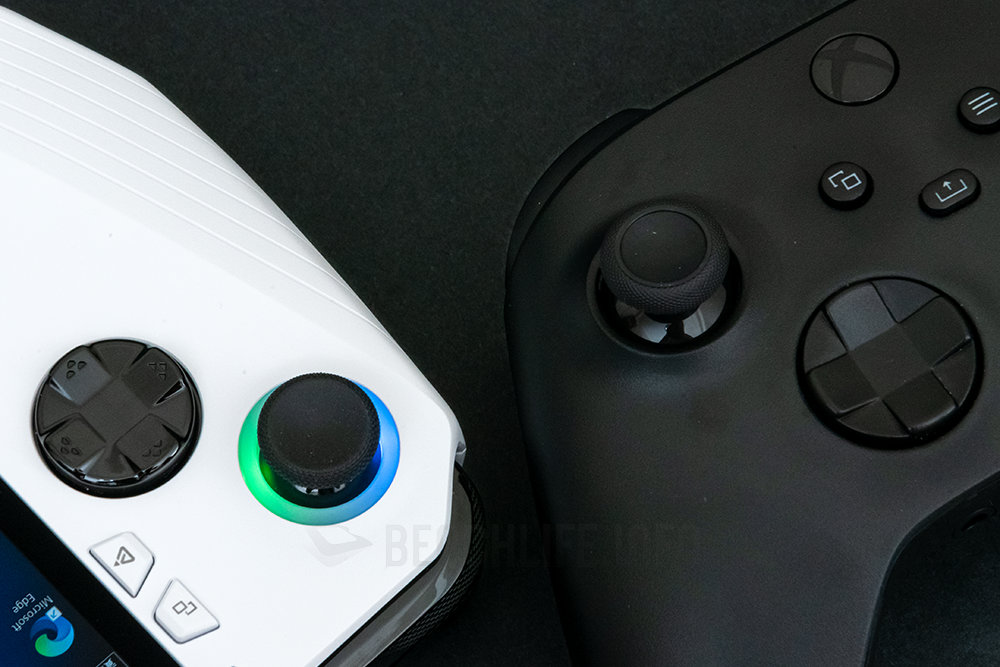

As mentioned earlier, the design difficulties and inevitable results, ROG Ally’s grip is different from that of controllers such as Xbox, and it’s probably a matter of opinion. After all, the ergonomic curve needs to be extreme, and the volume of the fuselage tends to become too large, the shape becomes more irregular, and it will be a little more troublesome to carry it out and store it.But at least the anti-slip treatment on the surface of the shell is not lacking at all. There is no sudden slippery feeling when holding the ROG Ally. I am afraid of being careless, thank yougodfatherSupport to buy again.
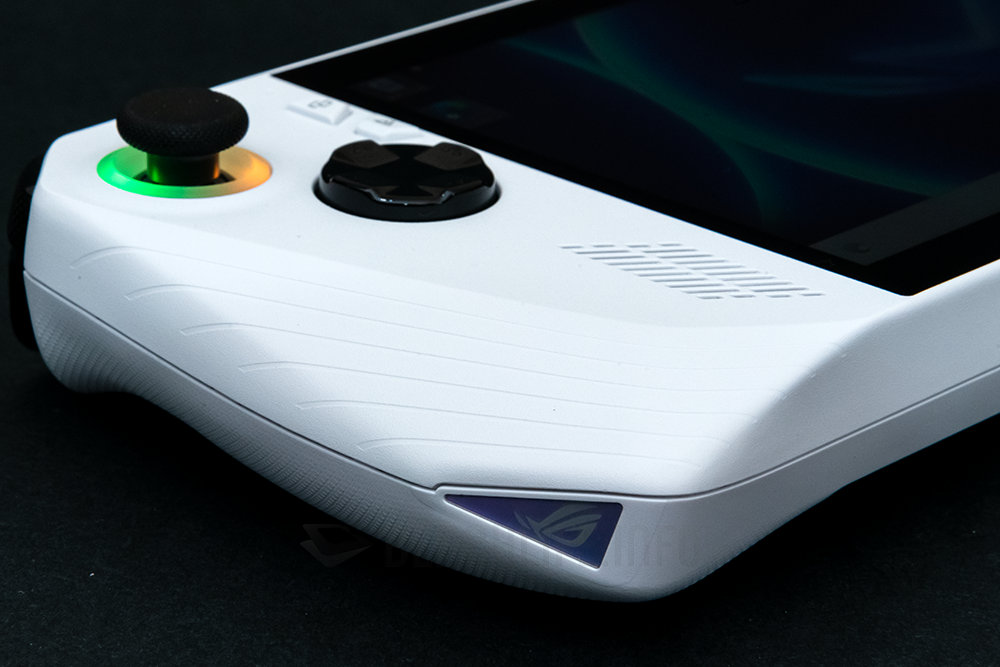

ROG Ally software layer design configuration
For ROG Ally, you can actually imagine it this way. It is like the UMPC promoted by Intel more than ten years ago, removing the mini keyboard but adding a handle. Because it uses the Windows 11 operating system, it can provide a familiar operation interface, as well as software and hardware compatibility and application flexibility. However, this open environment is relatively open, and manufacturers need to spend more effort on the experience of the software layer, otherwise, I am afraid that it will only reduce the interest in the game.
The boot process of ROG Ally is just like your familiar Windows experience. After entering the desktop, Armory Crate SE will automatically open. With the game collection library and other functions in the software, it creates an experience like the main screen of a home game console. Currently, game platforms such as Xbox, Steam, Battle, Epic, Ubisoft, EA App, and GOG Galaxy are supported, and installed games will also be displayed, which simplifies the inconvenience of starting the game a little.

It’s just a little bit. In fact, the Armory Crate SE game library is more like the sum of shortcuts. In addition to Steam, it only starts the game platform program, and the two windows operate independently. The experience is no different from the Windows operation logic you are familiar with. Armory Crate SE also includes a quick download guide for each game platform program. Since the download page is only opened through a browser, of course, it can also be downloaded and installed manually.
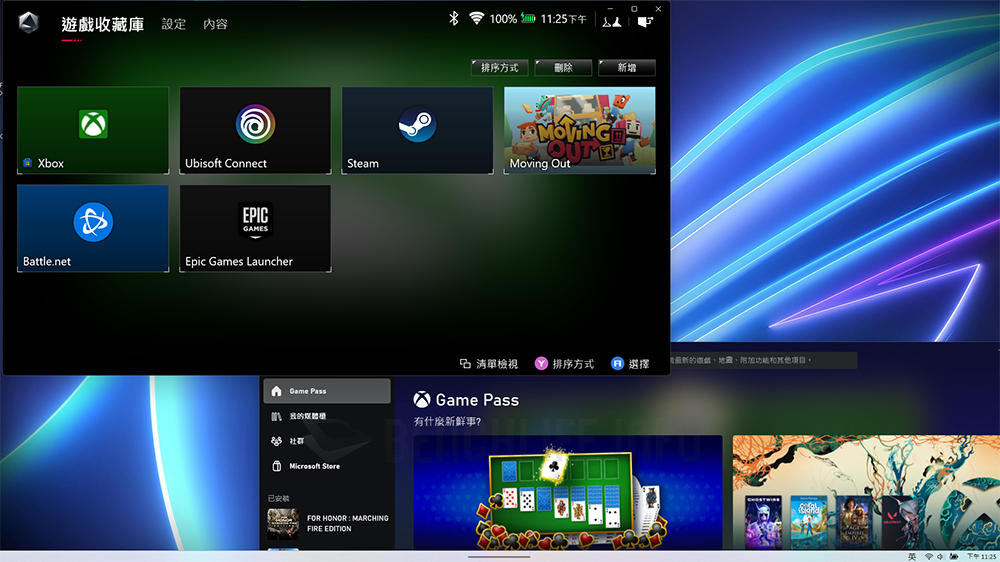
The functional settings are integrated in Armory Crate SE. The control mode provides two modes: game controller and desktop. In addition to allowing custom button mapping, you can also adjust the dead zone of the left/right joystick, external threshold, and trigger dead zone. , left and right vibration intensity. The Aura Sync lighting effect of the joystick can also be customized and supports synchronization. Practical functions include audio. Both the speaker and microphone support AI noise reduction. The former also includes radio mode options.

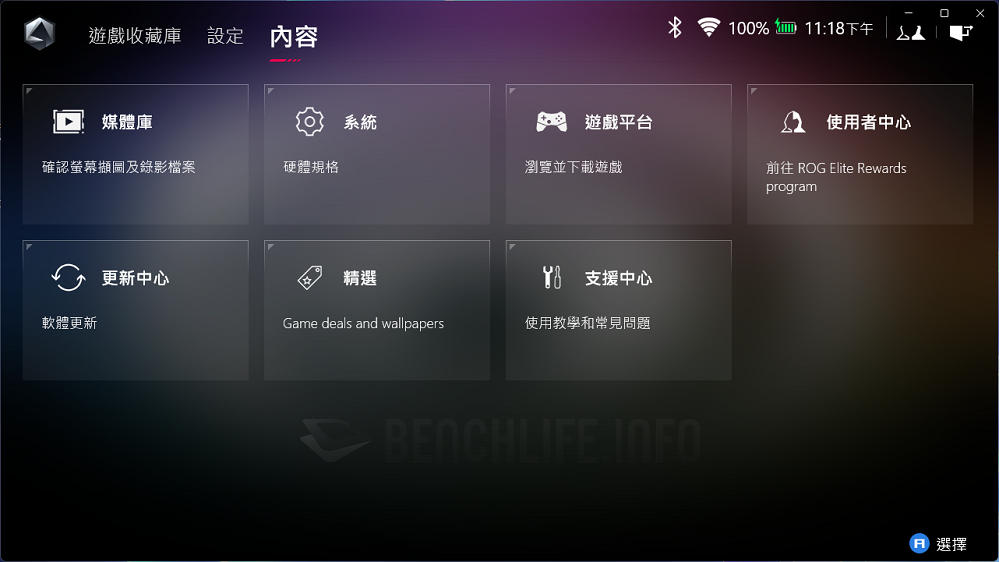
In daily use, if you don’t want to touch the screen frequently to avoid getting it dirty, the joystick on the right can also be used as a mouse, while the left can be used as a direction button depending on the situation. However, in the Windows environment, for game console applications, it is not convenient enough to just open the game, let alone other related settings. Therefore, ASUS added 4 additional function buttons under the microphones on both sides of the screen to match with the software layer, so as to enhance the user experience of the human-machine interface.
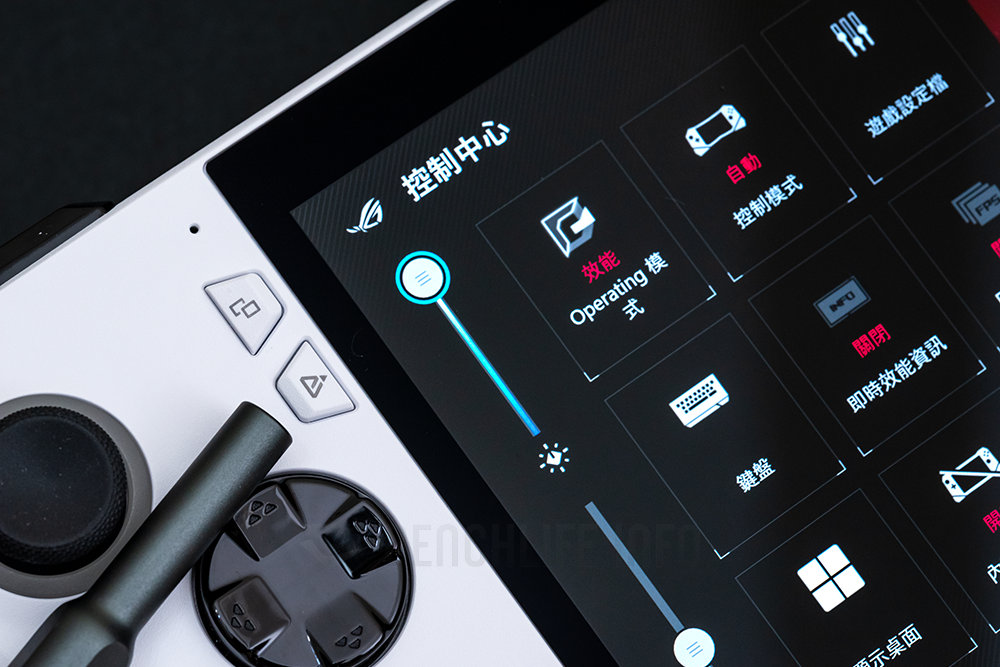
These 4 buttons can mainly call out Armory Crate SE, which can switch the game library arrangement, switch the Windows program window, or call out the control center for quick adjustment settings. The quick selection items displayed in the control center can be selected in the Armory Crate SE settings, mainly to quickly adjust the screen brightness, operation mode, handle mode, FPS limiter, frame rate, AMD RSR, etc.

ROG Ally core hardware configuration
The current version of ROG Ally uses AMD Ryzen Z1 Extreme APU. This Zen 4 architecture processing is 8C / 16T, with an acceleration clock of up to 5.1GHz. Its built-in Radeon Graphics has 12 RDNA 3 architecture processing units. In addition, it is equipped with 16GB capacity LPDDR5-6400 memory (dual channel, shared), and M.2 Type 2230 / PCIe 4.0 NVMe solid state drive module, and the default configuration capacity is 512GB.
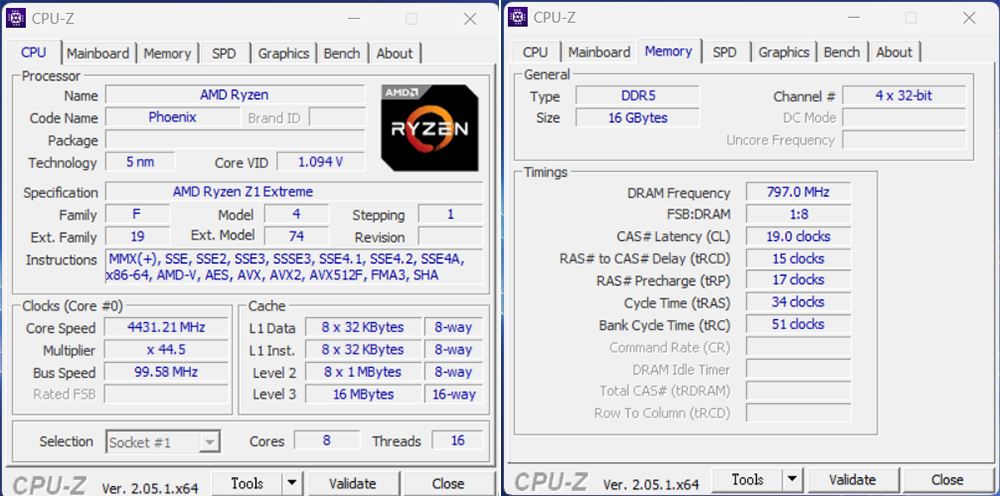
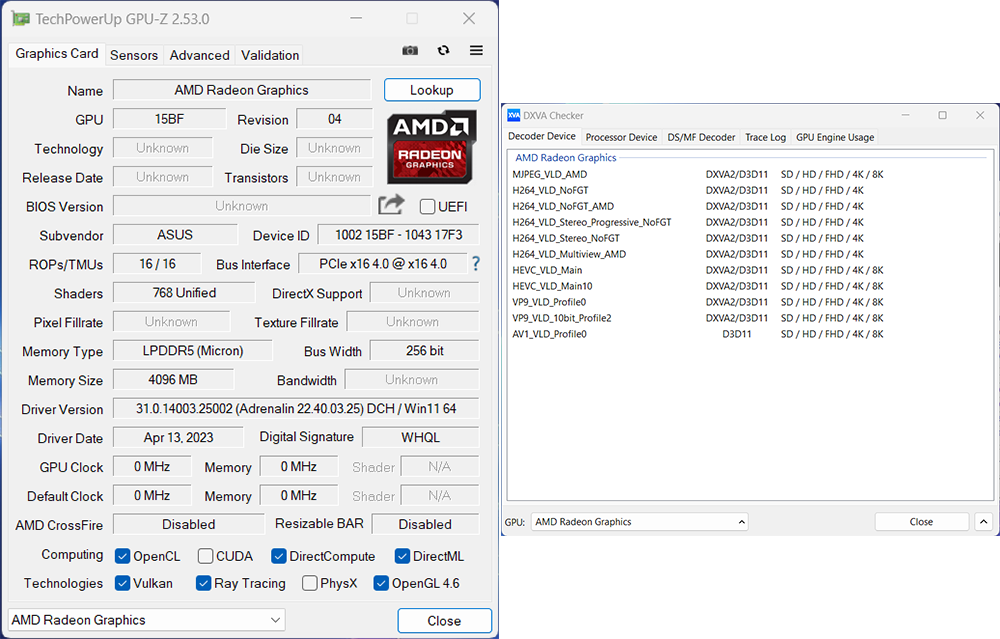
The capacity of the solid-state hard drive cannot be said to be large, so ASUS reserves the flexibility to replace the module, but it is relatively easy to expand through the UHS-II memory card. As for the wireless network module using the AMD package, the RZ616 Wi-Fi 6E (MT7922) is a collaboration with MediaTek and has a built-in integrated Bluetooth 5.2 interface. As for the built-in battery capacity of 40Wh, it supports USB PD fast charging design, which can be charged to 50% in 30 minutes.
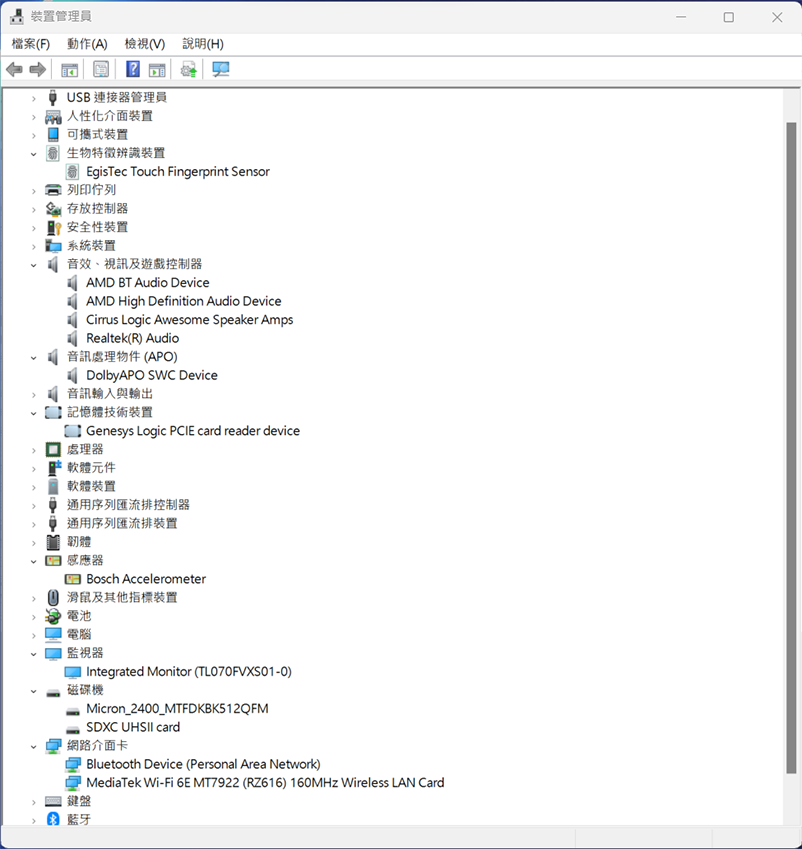
The Ryzen Z1 Extreme APU can be configured with a TDP of 9-30W, which is comparable to the processors commonly used in office laptops, so heat dissipation cannot be ignored. ASUS adopts a zero-gravity thermal system design. Even when the handheld is tilted or even close to vertical, the anti-gravity heat dissipation duct can still effectively circulate heat and cold. The heat is guided to 0.1mm aluminum fins, and then exhausted by 2 hydrodynamic bearing fans, so the body has 2 air outlets.
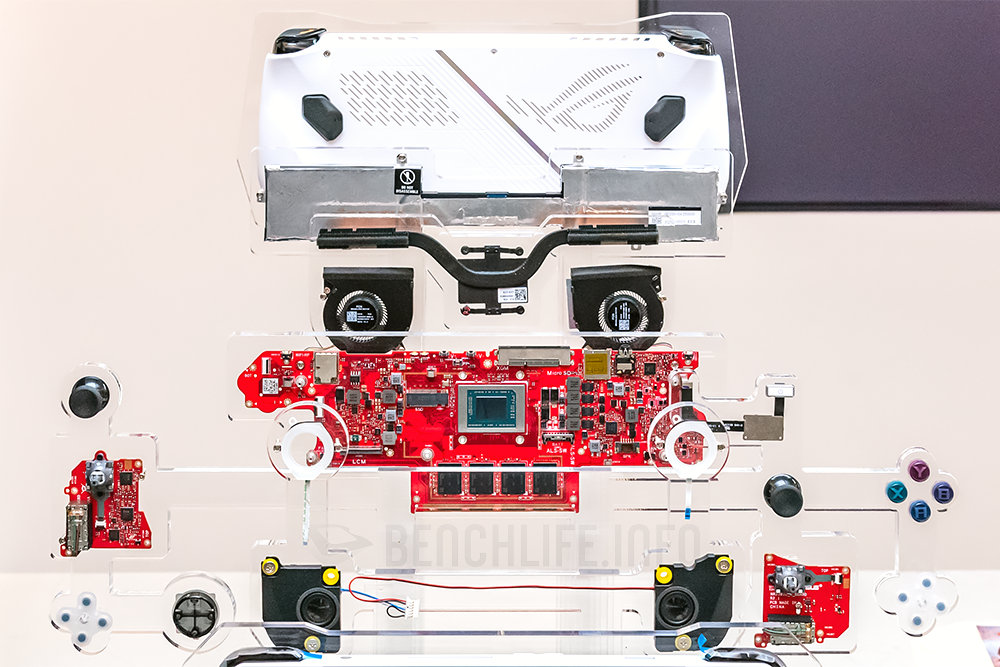
Based on the configurable TDP flexibility of the Ryzen Z1 Extreme APU, ASUS provides extreme speed, performance, and silent operation modes in Armory Crate SE, each with different TDP upper limit, cooling strategy/noise, and Windows power configuration. In addition, you can also choose to customize. SPL, sPPT, fPPT and other items all use power as the adjustment unit. However, it seems that the fan operation strategy cannot be selected by yourself.
ROG Ally performance measurement experience
ROG Ally will also detect whether the included power supply device is connected, and switch to the preset optimal configuration by itself. Under this condition, it will enter the extreme speed mode, and the Ryzen Z1 Extreme APU is adjusted to SPL (continuous power) 25 / 30W, sPPT (same as Intel PL2) 30/43W. Use this to conduct the following performance tests. First, execute some benchmark performance items, so that you can refer to the approximate performance level of the Ryzen Z1 Extreme APU.
| ROG Ally | ||
|---|---|---|
| Geekbench 6 | ||
| Multi-Core Performance | Multi-Core Score | 10303 |
| Mother-in-law intact | 9757 | |
| Floating Point Socre | 11399 | |
| Single-Core Performance | Single-Core Score | 2336 |
| Mother-in-law intact | 2369 | |
| Floating Point Socre | 2276 | |
| OpenCL Performance | OpenCL Score | 31705 |
| Vulkan Performance | Vulkan Score | 35608 |
| AIDA64 Cache & Memory Benchmark | ||
| Read | (MB/s) | 50567 |
| Write | (MB/s) | 91705 |
| Copy | (MB/s) | 68433 |
| 3D Particle Movement | ||
| Total Score | (Mops/sec) | 2865.94 |
| 3DTrig | (Mops/sec) | 491.1223 |
| BiPy | (Mops/sec) | 1015.3964 |
| P1rRjct | (Mops/sec) | 588.3922 |
| Cosine | (Mops/sec) | 247.2663 |
| HypCube | (Mops/sec) | 338.9109 |
| NormDev | (Mops/sec) | 184.8526 |
| 7-Zip | ||
| overall rating | (GYPSUM) | 85.002 |
| compression rating | (GYPSUM) | 70.693 |
| unzip rating | (GYPSUM) | 99.311 |
| Nero Score | ||
| Nero Score | 3793 | |
| CPU | Fraction | 2189 |
| AI marker | 2298 | |
| AVC decoding and encoding | 2080 | |
| GPU | Fraction | 1604 |
| AVC decoding and encoding | 3020 | |
| metaverse | 187 | |
| Cinebench R23 | ||
| CPU – Multi Core | (pts) | 14180 |
| CPU – Single Core | (pts) | 1765 |
| Blender Benchmark | ||
| CPU | monster | 94.394392 |
| junkshop | 57.676387 | |
| classrom | 46.3105 | |

| ROG Ally | ||
|---|---|---|
| PCMark 10 | ||
| Extended Score | 6859 | |
| Essentials | Score | 10770 |
| App Start-up Score | 15216 | |
| Video Conferencing Score | 8370 | |
| Web Browsing Score | 9809 | |
| Productivity | Score | 10572 |
| Spreadsheets Score | 13051 | |
| Writing Score | 8565 | |
| Digital Content Creation | Score | 8662 |
| Photo Editing Score | 12516 | |
| Rendering and Visualization Score | 8826 | |
| Video Editing Score | 5885 | |
| Gaming | Score | 6066 |
| Graphics score | 7752 | |
| Physics score | 23768 | |
| Combined score | 2907 | |
| CrossMark | ||
| total score | 1616 | |
| productive forces | 1604 | |
| creativity | 1720 | |
| reaction | 1370 | |
| WebXPRT 4 | ||
| Score | 284 | |
| photo enhancement | (ms) | 271 |
| Organize Photos Using Artificial Intelligence | (ms) | 1336 |
| stock option pricing | (ms) | 76 |
| Wasm-based encrypted notes and OCR scanning | (ms) | 772 |
| sales chart | (ms) | 198 |
| network homework | (ms) | 1782 |
As for the game part, it is unified at 1080p resolution, vertical sync is turned off, and medium texture quality is used for testing. In addition, the silent mode is added as a comparison. Its settings are only SPL 9W and sPPT 14W, which is suitable for use scenarios where performance requirements are not high but battery life is important. As far as the results are concerned, for the sake of smoothness and even the benefit of the 120Hz panel, depending on the game, the appropriate downgrade of the texture and the use of the FSR function will be more ideal. After all, the screen is only a small 7-inch. Enjoying the entertainment brought by the game is more realistic than worrying about the quality of textures.
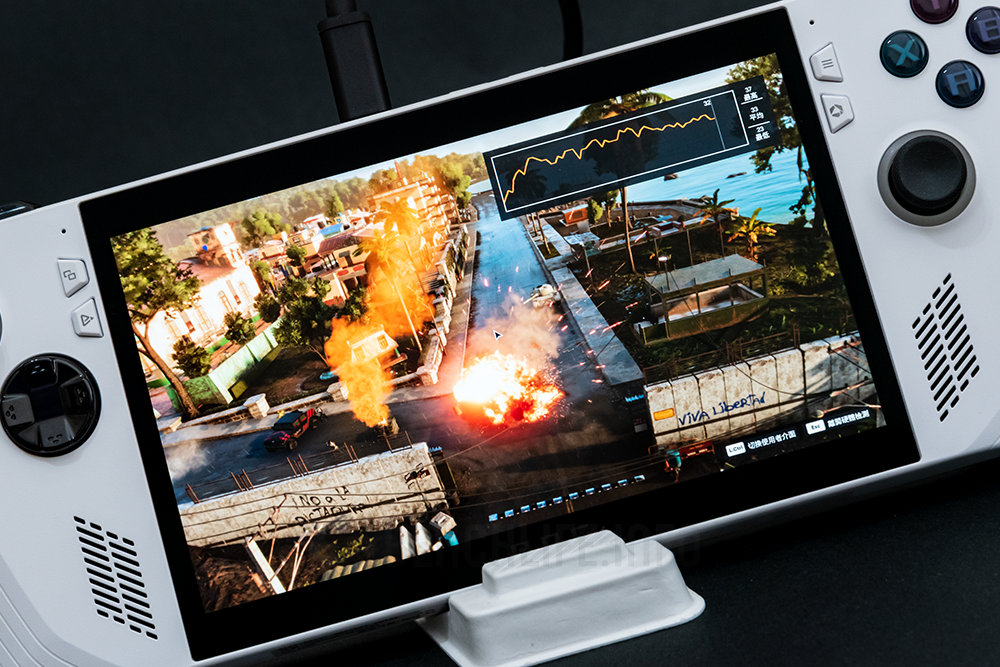
| ROG Ally | |||
|---|---|---|---|
| 3DMark | Extreme mode | silent mode | |
| Speed Way | socre | 360 | 193 |
| Fire Strike | Score | 7258 | 3814 |
| Graphics score | 7731 | 5287 | |
| Physics socre | 24168 | 9128 | |
| Combined score | 2895 | 963 | |
| Night Raid | Score | 27749 | 11373 |
| Graphics score | 35052 | 14329 | |
| CPU score | 12726 | 5244 | |
| ROG Ally game screen average frame rate (FPS) | API | AMD FSR | Extreme mode | silent mode |
|---|---|---|---|---|
| Ashes of the Singularity: Escalation | DirectX 12 | 42.4 | 15.6 | |
| Borderlands 3 | DirectX 12 | 44.78 | 14.73 | |
| Call of Duty:Modern Warfare II 2022 | DirectX 12 | 83 | 24 | |
| FSR 1.0 Balanced | 86 | 24 | ||
| FSR 2.1 Balanced | 71 | 21 | ||
| Cyberpunk 2077 | DirectX 12 | 30.27 | 10.86 | |
| FSR 2.1 | 39.99 | 13.13 | ||
| Far Cry 6 | DirectX 12 | 46 | 15 | |
| FSR 1.0 very high quality | 57 | 17 | ||
| For Honor | DirectX 11 | 55.49 | 18.77 | |
| Immortals Fenyx Rising | DirectX 11 | 39 | 11 | |
| Shadow of the Tomb Raider | DirectX 11 | 40 | 12 | |
| Tom Clancy’s Ghost Recon Breakpoint | DirectX 11 | 60 | 19 | |
| Tom Clancy’s Rainbow Six Extraction | DirectX 12 | 70 | 40 | |
| Tom Clancy’s The Division 2 | DirectX 12 | 51 | 16 |
During the period, I continued to pay attention to the temperature of ROG Ally. The 3DMark Fire Strike Stress Test is taken as a representative below. The extreme speed mode has a rating of 95.7 and is almost ready to be turned off. The maximum temperature during the test is 95°C, and the processor reaches 98°C. The silent mode is relatively acceptable, but the performance, as shown in the previous game tests, mostly reaches a multiple gap.
In fact, during the test experience, the highest temperature was as high as 95°C, and the solid-state hard drive often reached 70°C, and the storage test alone even showed a record of 80°C. The calorific value of ROG Ally does not seem to be underestimated, and it is a bit higher than the official high temperature of about 80°C. Due to the test environment and even seasonal differences, we do not think that ASUS’s declared value is a big problem.
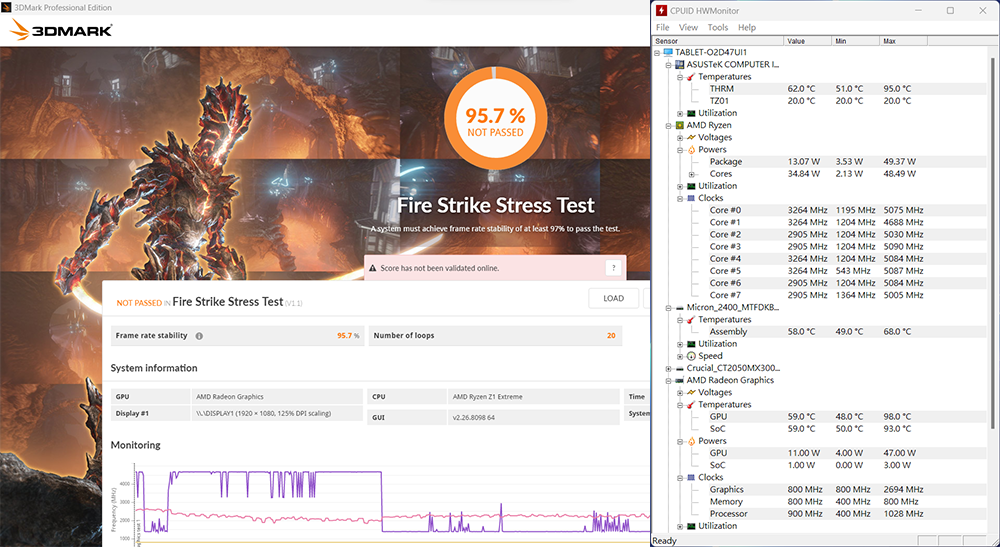

The operating mode affects the battery life. In the PCMark Gaming test, the extreme mode is only 96 minutes (the screen brightness is 50%, and the color calibrator confirms that it is about 150nits). In addition, the silent mode is tested and the screen brightness is set at 40% (about 120nits). The battery life can reach 166 minutes. As for the charging speed, ASUS advertises that it only takes 30 minutes to charge from 0% to 50% of the power, and the actual observation of its USB PD charging results is consistent.


Of course, using extreme speed mode will not always be in a high temperature state. Simply take YouTube high-definition video playback as an example. The Ryzen Z1 Extreme APU supports the AV1 audio-visual format. The resource utilization rate of the processor and the internal graphics division is relatively low, and the temperature is not high within 60°C. In other words, according to the usage requirements and power supply conditions, switch the operation mode of ROG Ally at any time, and the heat and battery life should not be too much of a problem.
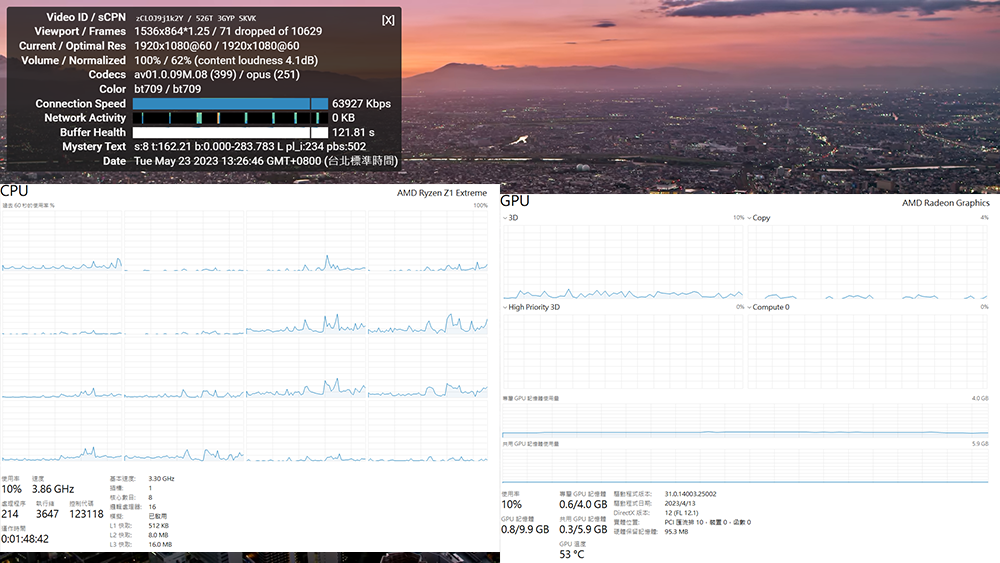
For daily use of ROG Ally, you can make good use of existing peripheral devices, such as a USB Type-C all-in-one hub that supports USB PD. It is very convenient to connect keyboards, mice, and storage devices. Of course, it can also be connected to TVs/monitors. The built-in Bluetooth is the same. In addition to the necessary headphones for going out, it can also be equipped with an independent controller. Therefore, it is not necessarily necessary to purchase exclusive accessories, and ROG Ally can also be used as a game console.
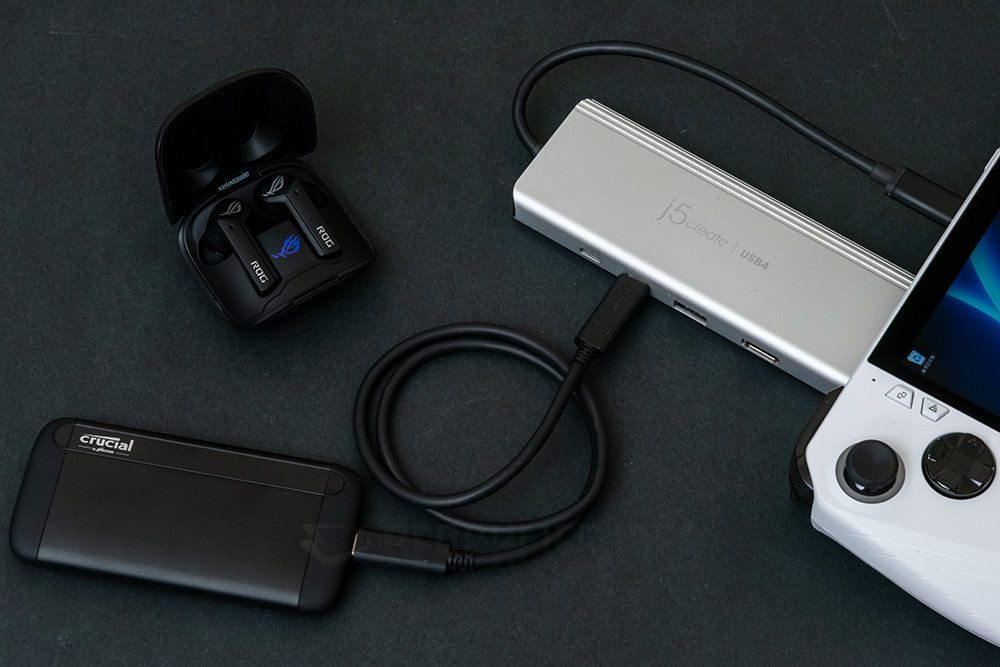
In addition, as mentioned above, storage capacity expansion is a bit limited, and ASUS recommends using UHS-II memory cards. In a simple experiment, the speed is slightly lower than the strength of the memory card used, about 50MB/s slower. In addition, through the FINAL FANTASY XIV: Shadowbringers Benchmark test, the total loading time is 15.599 seconds for the built-in solid-state drive, and 31.859 seconds for the sample memory card. The overall experience gap is quite obvious.

Above, ROG Ally’s performance, temperature, battery life and other key points, we don’t think there are any major problems, or people are particularly concerned. After all, this is ASUS’s first product, and it is also limited by current technology. They have tried their best to make it as acceptable as possible. Don’t forget that the suggested price of ROG Ally in Taiwan is 23,999 yuan. If it can be better or even fly into the sky, then it will not only sell at this price.
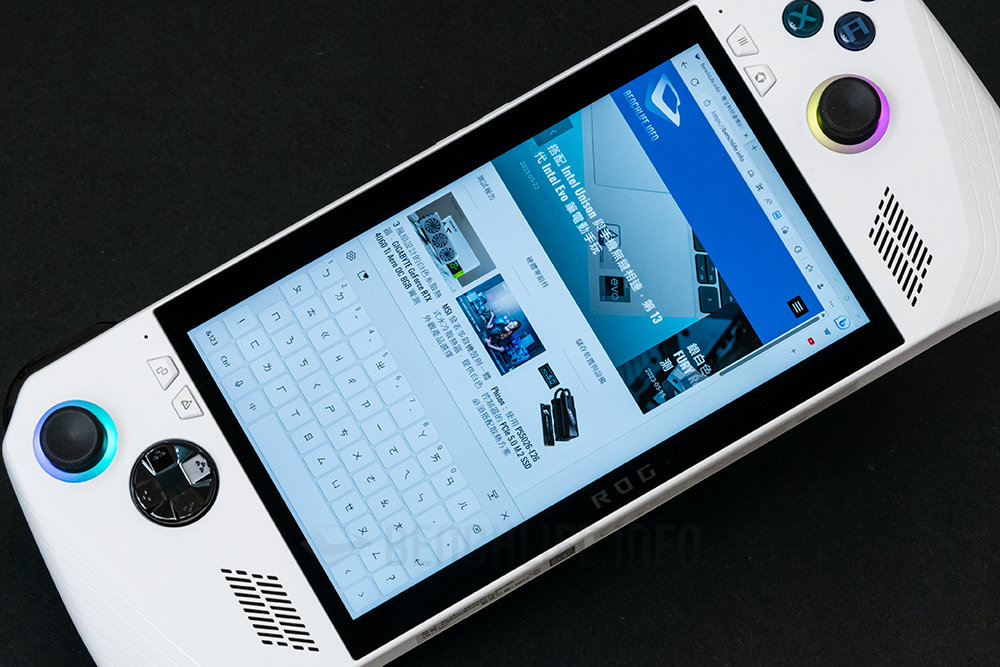
The actual grip experience is the same, the joystick and button operation feel are good, but the size of the LB and RB triggers is obviously smaller than the controller of the game console due to the limitation of available space (vertical height of the whole machine), and it takes a little time To adapt to the sense of operation. The screen and sound effects are naturally even more of a problem. Although the display panel does not support HDR, the maximum brightness is sufficient for use, and the sound effect is also good with additional software.
What can be expected, if Armory Crate SE can start the game more directly, then the experience will be more like a game console. This is probably due to the in-depth cooperation between ASUS and Microsoft and various game platforms. It may be difficult to imagine, so to what extent it can develop in the future, we can only continue to watch~

